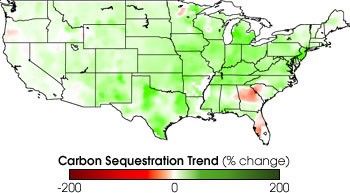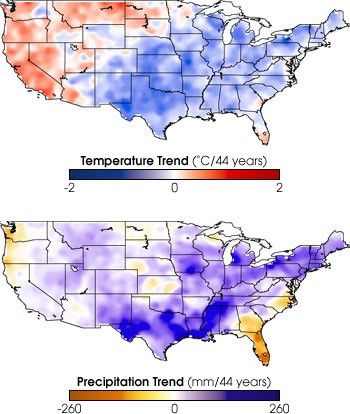Contrary to popular opinion, when it comes to greenhouse gas emissions, the United States cannot accurately be labeled as all give and no take. In fact, of the 5 billion tons of carbon dioxide our consumer driven country coughs up a year, roughly 15 to 30 percent is reabsorbed back into the land. Scientists refer to such a draw down of carbon as a carbon sink. Though researchers have known of this North American carbon sink for the better part of the 20th century, they do not understand precisely what is causing the sink or why the amount of carbon absorbed seems to increase over the years.

The most popular theories revolve around an observed greening of North America. Plant life appears to have thrived over the last 100 years, and increased vegetation growth has simply absorbed more CO2 from the air, increasing the carbon sink and partially offsetting greenhouse gas warming. In the presence of water and sunlight, plants take in CO2 during photosynthesis to create fuel, glucose, and other sugars for building plant structures.
Viable causes for why plants have done so well include a revival of forests from agricultural and urban clear-cutting in the 1800s, greater concentrations of atmospheric CO2 from fossil fuel burning, and warmer global temperatures in the 1900s. But a new study points to another factor vital to plant growth that may be at the root of the matter—more water.
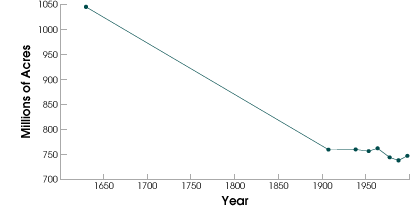
According to the NASA-funded study that used 100 years of temperature and precipitation-related data, computer model results showed that on average from 1950 to 1993, an 8 percent increase in precipitation combined with higher humidity has led to a 14 percent increase in plant growth in the United States. The data over that period also show increases in cloud cover, minimum surface temperatures, soil moisture, and stream flows, which are all signs of a changing water cycle.

Over the past 100 years, vegetation productivity (green line) has followed changes in precipitation (blue line) much more closely than changes in temperature (red line). Vegetation productivity is a measure of how much carbon plants are consuming as they grow. (Graph adapted from Nemani, Ramakrishna; White, Michael; Thornton, Peter; Nishida, Kenlo; Reddy, Swarna; Jenkins, Jennifer; and Running, Steven, 2002: Recent trends in hydrologic balance have enhanced the terrestrial carbon sink in the United States, Geophysical Researc Letters, Vol. 29, No. 10.)
While the connection between water availability and plant growth may appear obvious, there are complex interactions at play here that make a positive uptake of carbon possible. “Most people only think of the idea that more water means more growth, but really plants benefit from more water in a number of ways,” says Running. The increased rate of the carbon sink results from a synchronous interplay between plant physiology and both the timing and magnitude of changes that impact the water cycle.
The study finds that between 1950 and 1993, the minimum temperatures in the spring have become warmer and the autumns have become wetter, which may have combined to lengthen the growing season, giving plants a longer time frame for photosynthesis. But without the right coincidence of both temperature and water availability, the growing season would likely not have lengthened. Between 1910 and 1940, for example, there was a warming trend in the winter, a season when plants do not grow. The same principle is true for rainfall. “If you get rain in winter, it doesn’t make a big difference for the plants, but in the autumn, it does,” adds Nemani.
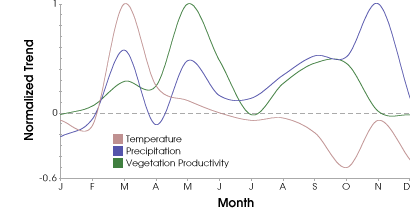
In addition, a longer growing season must also be combined with more humidity and rain for vegetation to uptake more carbon. Without water, a long hot summer can lead to droughts. “A longer growing season independent of high water availability isn't necessarily good for terrestrial carbon storage,” says Michael White, an assistant professor at Utah State University’s Department of Aquatic, Watershed, and Earth Resources and another co-author of the study. White adds that higher temperatures cause organic matter in the soil to release more carbon dioxide, while low moisture limits photosynthesis in plants.
Previous research has claimed that the observed increases in plant growth result from a greater abundance of atmospheric CO2. Though plants clearly require CO2 to grow, water and higher humidity make plants more efficient at drawing in carbon. In dry conditions, plants close special cells in their leaves, called stoma, to reduce the amount of water lost to the air through evaporation. Higher CO2 availability also promotes closure of these cells since the plants can have a smaller opening, save water, and take in the same amount of nutrients. But when the air is wetter, these pores can open without a net water loss, increasing CO2 uptake while reducing the amount of water needed to grow. “If you increase the rainfall you can sequester more carbon from the atmosphere,” Nemani says. Additionally, wetter soils promote decomposition of dead plant materials, releasing natural fertilizers that help plants grow.
For these reasons, the authors found that enhanced rainfall and humidity prove to be the main controlling factors in increasing plant growth and carbon uptake. While a number of studies focus on temperature changes as the cause of increased U.S. plant growth, this study finds that average U.S. temperatures over the last 100 years have stayed about the same, with a warming trend in the west, countered by cooling in the east. The researchers believe that other possible non-climate related factors, such as forest re-growth due to a decline of farms and a rebound of vegetation from earlier clear-cutting, could play a role in creating more plant life. But still, the study attributes two-thirds of the recent additional plant growth to higher humidity and more rainfall.
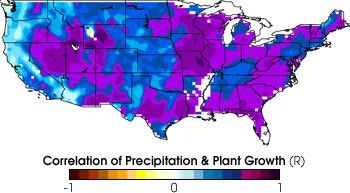
Though the results appear optimistic at face value, there are many interdependent variables at play here that impact the water and carbon cycles. Such carbon sinks, however, are unlikely to lower CO2 concentrations enough to cure global warming. Nemani also warns that changes in the hydrologic cycle will not occur uniformly around the world. Some places will receive more rainfall and other places will receive less, as is the case with current droughts in the Pacific Northwest and in much of Africa. “There will be winners and there will be losers,” Nemani says.
References
- Nemani, Ramakrishna; White, Michael; Thornton, Peter; Nishida, Kenlo; Reddy, Swarna; Jenkins, Jennifer; and Running, Steven, 2002: Recent trends in hydrologic balance have enhanced the terrestrial carbon sink in the United States, Geophysical Research Letters, Vol. 29, No. 10.
- Lovett, Richard A., June 7, 2002: Rain Might Be Leading Carbon Sink Factor, Science, Vol. 296, No. 5574, p. 1787.
- Whipple, Dan: Carbon Conundrum, Earth Observatory
- Herring, David and Kannenberg, Robert: The Mystery of the Missing Carbon, Earth Observatory
- Personal Interview with Ramakrishna Nemani, April 2002.
- Personal Interview with Steven Running, April 2002.
- Personal Interview with Michael White, June 2002.
NASA Earth Observatory story by Krishna Ramanujan; design by Robert Simmon



























